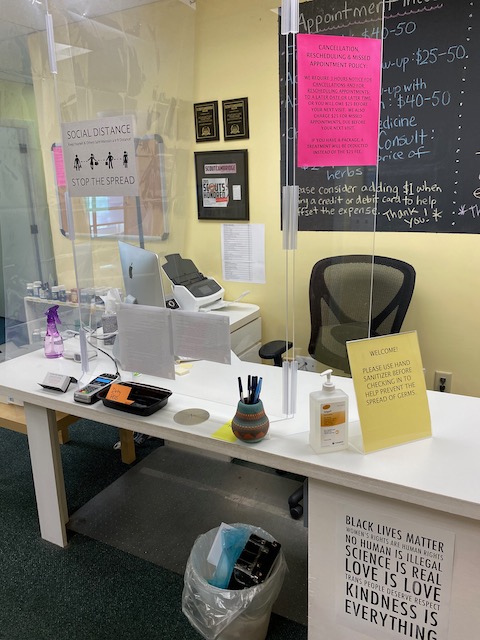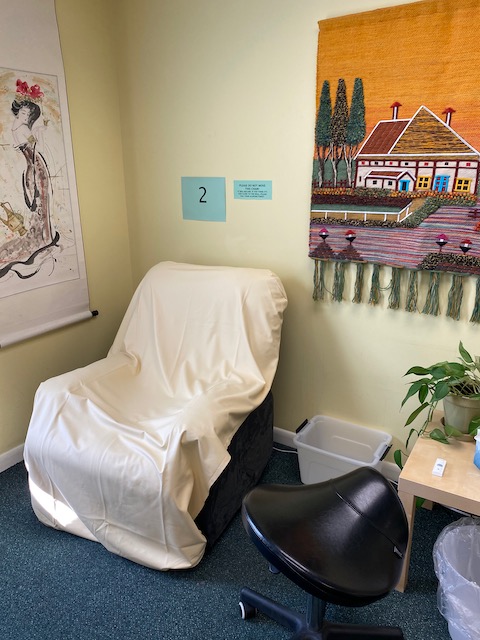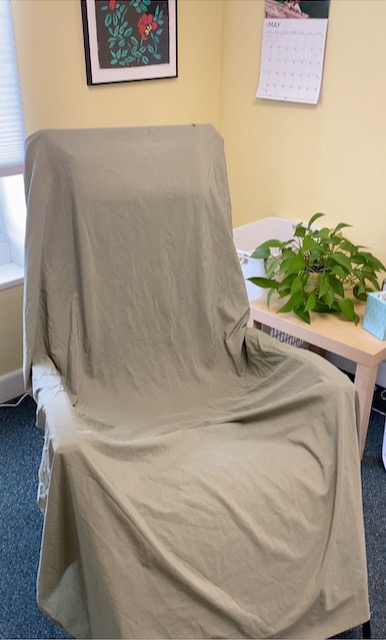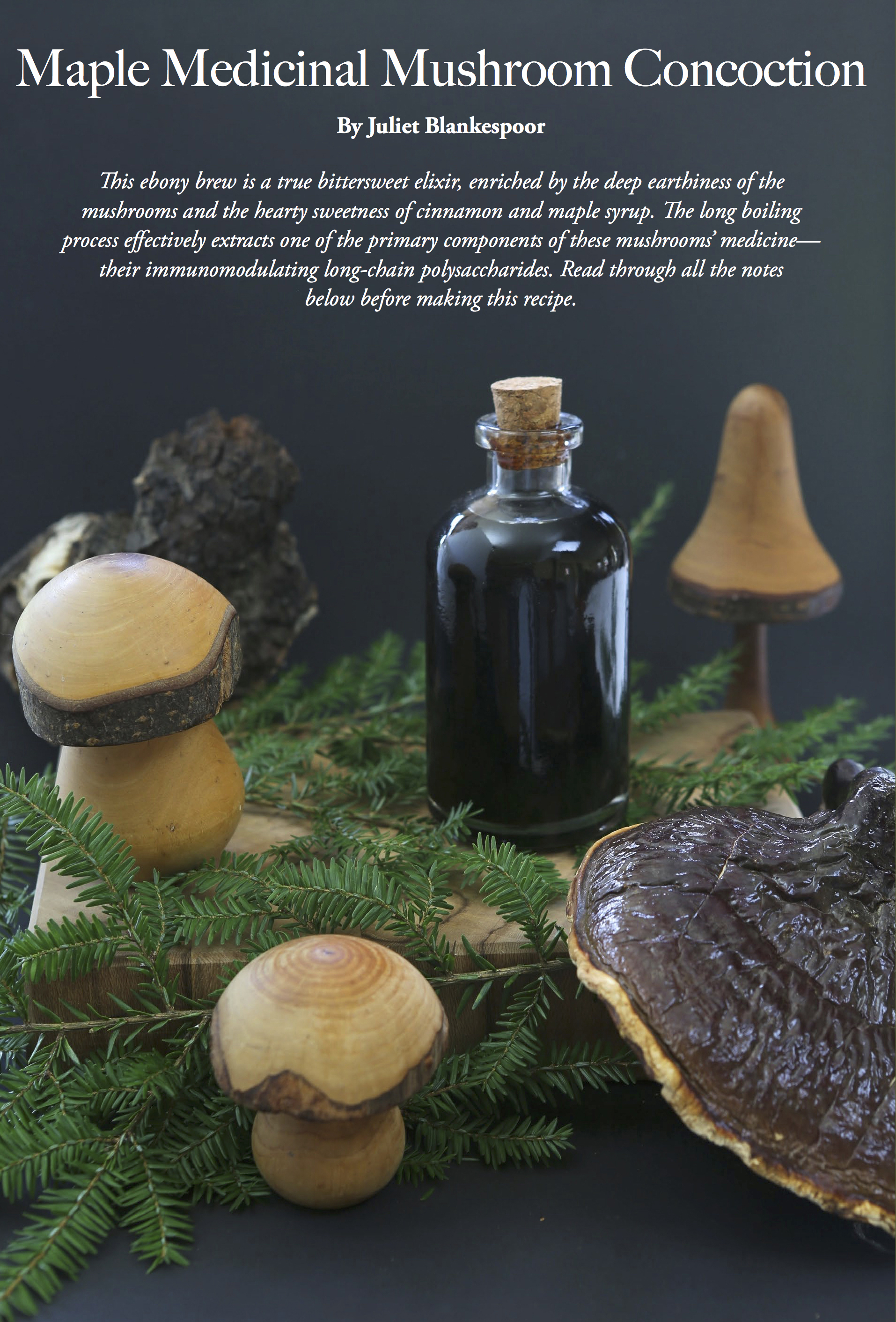Written by Meghan Gemma with Juliet Blankespoor
Photography by Juliet Blankespoor
(except where credited)

-
Your garden wants to feed you—not just with the cultivated plants you tuck into the soil, but with a profusion of wild greens and herbs that spring up of their own generous accord. These feral guests surpass domestic veggies in nutrition and are often brimming with medicine, which makes them worthy of our attention and care in cultivated spaces. In fact, you might consider celebrating their arrival with a bit of seasonal fanfare—another helping of compost, anyone?
These “weeds,” which include lamb’s quarters, plantain, and red clover, will naturally arrive and make themselves at home in your garden—and can peacefully cohabitate with planted veggies and herbs. You can employ plenty of tricks to help them play nice, and, as a reward for acting as a botanical referee, you’ll harvest even more food and medicine from your garden! This is the bounty that grows in-between: the medicine and food that you didn’t plant but still get to reap.
Plant teacher Frank Cook, who has passed on, used to say that more than half the bounty of a garden could be found in the “in-between” in the form of useful opportunistic plants. People all around the world capitalize on this abundant resource, casually “cultivating” weeds in the in-between spaces.
Let’s take lamb’s quarters (also known as wild spinach) as an example of this useful-weed-and-planted-crop polyculture. In my garden, I leave the lamb’s quarters that comes up between recently planted vegetable and herb crops. After harvesting the wild spinach for a few weeks or a month, the veggies fill out, and then I pull out the lamb’s quarters and use it as mulch for the garden. Wild spinach requires no additional tending and is relatively disease and insect free.
Why wouldn’t we invite low-maintenance and nutritious wild plants to populate our gardens? This is practical, sustainable, and reliable kitchen gardening at its best.
-

Lamb's quarters (Chenopodium album)
-
Lamb’s Quarters
(Chenopodium album, Amaranthaceae)
If I had to recommend just one wild food to let run rampant in your garden, it might be lamb’s quarters. This edible is common, easy to identify, and a nutritional powerhouse. In fact, lamb’s quarters is so desirable as a food plant that it was cultivated by early Eurasian and North American peoples—predating corn as a staple crop.1
Lamb’s quarters is well aware of the fertile opportunities presented by your garden, and will appear in the springtime as dainty seedlings with arrowhead- or goose foot-shaped leaves (cheno = goose, podium = foot). The seedlings quickly develop into stout plants that typically reach maturity at 3 to 5 feet (0.9–1.5 meters) in height. A classic identification trait is the textured, waxy bloom found on the undersides of the leaves resembling miniature pearls of dew.
I strongly favor the rich, mineral flavor of lamb’s quarters, which is also called wild spinach. Like many wild foods, lamb’s quarters is more nutritionally endowed than its domestic counterpart, garden spinach (Spinacia oleracea). It is a superior source of iron, calcium, zinc, and potassium, and also provides trace minerals, B-complex vitamins, and vitamin C. Plus, lamb’s quarters is delicious.
If you’re excited about bringing this nourishing plant into the kitchen, see our recipe for Wild Greens Pâté, or substitute a couple handfuls of lamb’s quarters leaves into saag paneer (a family favorite at our house). You can use lamb’s quarters anywhere that you would traditionally use spinach—in omelets, stir-fries, spanakopita, soups, and casseroles. The leaves can also be dried and reconstituted for later use.
If you’d like to know more about identifying, cultivating, and using wild spinach, please see our in-depth article on Lamb’s Quarters.
-

-
Plantain
(Plantago spp., Plantaginaceae)
I rejoice at plantain’s return each spring, and return it does—in great numbers and with tenacious vigor. In truth, plantain seems to have a penchant for hard living—it’s not unusual to find it spreading its leaves over the gravelly surface of driveways and parking lots. You’re also likely to see it sprinkled about the lawn and certainly in the soft soil of your garden (even tough plants like to take it easy sometimes). This adaptability means that plantain is almost always around when you need it—which may be more often than you’d think. I’m not exaggerating when I say plantain is one of my most reached-for warm season remedies.
You will commonly see and use two types of plantain for medicine: broadleaf plantain (Plantago major) and narrowleaf plantain (P. lanceolata). The botanical differences are implied in their names: broadleaf plantain has wide, oval-shaped leaves, while narrowleaf plantain bears leaves that are long and slender. Both species grow basal leaves, although P. major’s will hug the ground more closely than P. lanceolata’s, whose leaves stand more erect.
The flowers of each species are also remarkable and distinct. P. major raises a sturdy green stalk that bears miniature white blooms and, eventually, a motherload of tiny seeds. The stalk, which I liken to a wizard’s wand, may wave anywhere between 3 inches and 1 foot (7 to 30 cm) in height. P. lanceolata, on the other hand, sprouts long, slender stems upon which sits one wizard’s hat each—a cylindrical or cone-shaped flower head encircled by starry white flowers and stamens.
The plantains possess prominent parallel leaf ribs that become fibrous and stringy by late spring. If you plan to dine on plantain, it’s best to gather the tender greens early in the season and add them fresh to salads and smoothies. Later, when the leaves become tough to chew, they can still be used in teas, fresh-pressed juices, and soup stocks.
I will say that I keep a close eye on plantain in the garden. A few years back, I encouraged several narrowleaf plantains to languish in my herb and vegetable beds for the sheer appreciation of their beauty. However, when it came time for the plants to disperse their seeds, they went straight to town (and to every corner of the garden). I still welcome plantain into my cultivated spaces, but I take care to snip off the flowering parts before they set seed.
Note: The plantains we’re discussing here are not related to the banana-like fruit by the same name (Musa genus).
Plantain’s Medicinal Uses
Parts used: Leaves and seeds (all plantain species are interchangeable as medicine)
Preparations: Infusion, poultice, salve, sitz bath, food, vinegar
Herbal Actions:
- Vulnerary
- Demulcent
- Anti-inflammatory
- Antimicrobial
- Mild astringent
- Nutritive
- Expectorant
Plantain is one of our finest first aid remedies, in large part because it’s so common and therefore frequently on hand right when you need it. It is also a true and proven healer that quickly brings cooling, moistening relief to rashes, burns, blisters, and other skin inflammations. Its cooling properties calm painful heat and its vulnerary qualities help to repair tissues. This also makes plantain a remedy of choice for wounds, cuts, scrapes, splinters, and bites and stings from insects, spiders, bees, and mosquitoes. Plantain’s antimicrobial qualities make it effective even when infection is present.
On a recent barefoot walk in the woods, I stepped on a piece of glass that left a small sliver embedded in my foot. I wasn’t able to remove the shard and it quickly became too painful to walk without limping. I stopped to soak my foot in a cold mountain stream and then picked a few leaves: wild hydrangea (Hydrangea arborescens) for astringency and sheer softness, yarrow (Achillea millefolium) for its anti-inflammatory and antibacterial properties, and plantain for quick, cool relief. I chewed everything up, spit it out in my hand, and applied the wad to the bottom of my foot. I sealed the poultice with a violet leaf (Viola spp.) and slipped a sandal on. While I continued to favor my other foot, the relief was immense and immediate. The next morning, the pain and swelling were gone altogether.
Plantain’s fresh leaves, applied as the elegantly simple chew-and-spit poultice described above, is a classic on-the-fly remedy that you’ll likely use again and again. You can also dry the leaves for winter use, rehydrating them with a little warm water as needed.
Taken internally, plantain is a healer for inflammatory conditions of the digestive tract—ulcers, leaky gut, acid reflux, and irritable bowel syndrome (IBS). A strong infusion of the leaves is recommended for best results, although it can also be taken as food. The seeds, which are high in mucilaginous fiber, are moistening to the digestive tract and can aid in bowel regularity.2
The strong tea is soothing for hot, dry conditions of the lungs, including persistent, hacking coughs and irritation from inhaling particulate matter. Recently, I was spreading mulch on my garden from a round bale of hay. As I pulled armfuls away from a moldy portion of the bale, the air filled with green clouds of fungal spores. Half an hour later, I was coughing in fits and my lungs were aching. This persisted for a couple of hours before I took action (silly herbalist faux pas) and brewed up a pint of plantain and peppermint (Mentha x piperita) tea. In less than 15 minutes my cough had subsided and my chest had relaxed. The effect was so notable my partner commented on it before bed. Give thanks for the common healing herbs!
Contraindications: There are no known contraindications.
-

-
Red Clover
(Trifolium pratense, Fabaceae)
The swaying grace of red clover in bloom is reason enough to let it grow up between your lettuce and kale. In general, I love flowers of all kinds mixed into the greenery of a garden—edible, medicinal, and ornamental. In this light, red clover has a lot to offer. The young leaves and fuschia flowers are edible; the blooms are medicinal, and they are altogether as charming as a meadow in May.
Red clover is also a nitrogen-fixing legume whose sturdy roots help to break up compacted or clayey soils. This means it works double-duty on behalf of your garden while it fulfills a cornucopia of other uses. It is often grown as a gorgeous cover crop for this reason. According to wild foods writer, Roger Phillips, red clover is traditionally planted in fields where corn has been grown to restore fertility to the soil, earning it the name “mother of corn.”3
Red clover is an early summer wildflower that grows in fields and pastures as well as in the welcoming earth of your garden. The leaves bear charming white chevrons, the sepals are intricately patterned, and the round blossoms dance along the pink-purple spectrum. Red clover is one of our tallest clovers, reaching toward the sky up to 18 inches (46 cm) or so in height.
As an edible, red clover’s flavor is fresh and sweet. Both the tender young leaves and fuzzy blossoms can be added to salads and such, and they make an enchanting garnish. I enjoy adding red clover to seasonal herbal vinegars—it makes a regular appearance in this Springtime Fairy Vinegar. Red clover tea is delicious, offering us both a pleasant medicine and a refreshing summertime beverage. The individual pink florets each cradle a drop of nectar at their base—pull them from the flower head and enjoy much as you would honeysuckle.
Being possessed of a wide range of vitamins, minerals, and phytonutrients, red clover is a versatile and nourishing food-medicine. The leaves and flowers are rich in vitamins B and C, bioflavonoids, magnesium, zinc, copper, and selenium.1
Be sure to gather red clover in its freshest state, which is typically in late spring or early summer. Pinch off the flower heads, including the leaves nestled beneath the blooms. If the flowers are beginning to turn brown, pass them by. Use fresh, or dry immediately.
Drying red clover requires special care as the blossoms can easily mold, oxidize, and ferment. I like to spread them on a clean screen and place them in a dry, warm place with good airflow. I try to remember to shuffle them each day to disperse any lingering moisture. Because red clover requires extra care, I recommend growing or gathering your own if possible. Commercial red clover is often of poor quality.
Red Clover’s Medicinal Uses
Parts used: Flowering parts; upper leaves and blossoms
Preparations: Infusion, food, vinegar, poultice, oil
Herbal Actions:
- Alterative
- Lymphagogue
- Phytoestrogen
- Nutritive tonic
Red clover is a traditional liver and blood tonic, and an esteemed reproductive herb. I use it in two primary ways: as a cleansing, alterative remedy and as a phytoestrogen for addressing hormone imbalances in women.
As an alterative, red clover’s cleansing and detoxifying properties help rid the body of metabolic wastes as it nourishes the liver and kidneys. Combined with herbs like burdock (Arctium lappa, A. minus) and chickweed (Stellaria media), red clover is a beneficial daily tonic for skin conditions like acne, eczema, and psoriasis. Its proclivity for creating movement in the body also gently stimulates the lymph, and it can be used for lymphatic swellings and as a mild, nourishing medicine for the immune system.
Red clover is a classic herbal phytoestrogen—a source of plant estrogen that is capable of binding to estrogen-receptor sites in the body and eliciting an estrogenic effect. This makes red clover beneficial for folks with hormonal imbalances and conditions such as infertility, early menopause and menopausal complications, breast lumps or tenderness, irregular menstruation, and painful menstruation. See our article on phytoestrogens for a detailed explanation of how they function, when to use them, and how to integrate them into your diet.
As a complement to its other uses, red clover is deeply nutritive and can be taken daily as a nourishing tonic. It can aid in convalescence, debilitating illness, or when other foods are not desired. Its sweet flavor is building to the tissues and invites pleasure into the ritual of taking one’s medicine. Red clover is best prepared as tea for medicinal use so its mineral content is preserved.
Contraindications: Avoid using brown, moldy, or fermented blossoms. These can dangerously thin the blood. Red clover is a traditional folk remedy for cancers and lymphatic swellings. However, there is some speculation that its phytoestrogenic properties may exacerbate estrogen-receptor-positive cancer. Until there is more research, it is recommended that people who have, or have had, estrogen receptor-positive cancer refrain from using red clover.
Other Wild Edible + Medicinal Garden Herbs
Curious who else might show up to your garden party without RSVPing? The following guest list isn’t comprehensive and the descriptions are brief, but you’ll meet some of our all-time favorite herbal free spirits. Please do extra research on their medicinal and edible uses, identification, and possible contraindications. We’ve included links to our other articles where applicable, and you can refer to this list of our Favorite Foraging Books for field guides and culinary inspiration.
-

Harvesting chickweed (Stellaria media)
-
Chickweed (Stellaria media), with its starburst blooms and tender green leaves, is the forager’s poster child. It arrives in the cool, moist days of early spring and is likewise cooling and moistening as a medicine. Chickweed is a helpful remedy for hot, dry conditions like irritating coughs, acne, boils, diaper rash, and blisters. It is also a classic spring cleansing herb and nutritive wild food. You can read more about chickweed in our article on the Ten Best Wild Foods for Beginning Foragers + Wildcrafters.
-

Burdock (Arctium minus)
-
Burdock (Arctium minus, A. lappa) is a gorgeously leafy herb with a notable taproot. The tasty, medicinal root is bittersweet in flavor and contains high levels of inulin, a prebiotic nutrient relished by gut flora. It is a nutritive food-medicine par excellence, and I enjoy it in culinary dishes and dried for earthy wintertime teas. It has a nourishing effect on the detoxifying systems of the body and is a useful ally for skin conditions like acne and eczema. Keep reading about burdock’s edible and medicinal uses here.
-

Purslane (Portulaca oleracea). Photo courtesy of Steven Foster
-
Purslane (Portulaca oleracea) is an edible succulent, with branching stems and bright yellow flowers that open in the sunshine. It is one of the most populous weeds in the world, and is common throughout North America—in both hot climates and cool. The leaves are a fantastic source of potassium and iron, and have been found to be higher in omega-3 fatty acids than any other researched leafy green.4 Purslane can be added fresh to salads, sandwiches, and tacos, or pickled and added to ferments like kimchi. It can also be cooked, but this enhances the plant’s natural mucilage, which may be too slimy for some palettes.
-

Wood sorrel (Oxalis spp.). Photo courtesy of Steven Foster
-
Wood sorrel (Oxalis spp.) is a common, sour-flavored herb that makes itself right at home in the garden. Also called sour grass, sour clover, or lemon clover, wood sorrel is a favorite wild treat for children. Its three heart-shaped leaflets emerge from a central stem and are reminiscent of clover. There are many species, and all are edible. The garden variety that grows around my home bears yellow flowers, but they may also be pink or white. As far as food goes, the leaves are the main attraction, these being most tender and delicious before the flowers appear. Wood sorrel is a classic trail-side snack, but I also love it fresh in salads. Wild foods expert Samuel Thayer recommends it steeped in cold water (chopped finely first) and then strained for a tangy, lemonade-like refreshment.5
-

Dandelion (Taraxacum officinale)
-
Dandelion (Taraxacum officinale) is one of the first floral foods for bees in springtime, and is also one of the first wild greens of the year to appear on my family’s table. It is a classic edible that was cherished by many of our temperate-climate ancestors and has even been cultivated in kitchen gardens for its nutritious leaves, which can reach great lengths when pampered with a little compost. Dandelion is reemerging as a homegrown vegetable, but you likely needn’t bother; it will arrive of its own accord in no time. For the tastiest greens, choose new leaves from the heart of the plant. Use them raw in salads and smoothies, sautéed and topped with toasted sesame seeds, or added to wild pesto. The flowers can be fermented to make a fine dandelion wine, strewn across birthday cakes, or added to sparkly springtime drinks. Gather up more appreciation for dandelion here.
-

Cleavers (Galium aparine)
-
Cleavers (Galium aparine) is an emerald-green herb, imbued with the color and freshness of spring. It often sprouts up at the same time and in the same place as chickweed, and shares some tandem uses: as a seasonal cleansing herb and all-star ingredient in healing skin salves. For internal use, I much prefer my cleavers juiced. It can be combined with any other greens, fruits, herbs, or veggies. My favorite combination is a cleavers/pineapple duet, inspired by Rosemary Gladstar. Beware of sampling cleavers au naturel, as the stems, leaves, and seeds are all covered in itsy-bitsy hooks that can catch in your throat. Thus, it is not a salad herb. Instead, if you prefer, you can roll a stem or two into a tight ball between your fingers to disarm the hooks (a cleavers “pill”) and munch away. Want to use cleavers in one of my favorite seasonal remedies? Make a Springtime Fairy Vinegar using this recipe.
-

Violet (Viola spp.)
-
Violet (Viola spp.) is nearly unsurpassed in its destiny as an enchanting springtime herb. The flowers draw the eye with their bioflavonoid-rich purple petals, and the heart-shaped leaves are one of our primary medicines for spring cleansing, nourishing the lymph, and soothing wounded tissues. There are so many ways to partake of violet’s food and medicine that we’ve devoted a whole hub to this beloved herb. You’ll find materia medica, recipes, and a seasonal cleansing protocol.
-
References
- Brill S., Dean E. Identifying and Harvesting Edible and Medicinal Plants. New York: HarperCollins, 1994.
- De la Forêt R., Han E. Wild Remedies: How to Forage Healing Foods and Craft Your Own Herbal Medicine. Carlsbad: Hay House Publishing, 2020.
- Philips R. Wild Food: A Complete Guide for Foragers. London: Macmillan, 2014.
- Simopoulos A., Norman H., Gillaspy J., Duke J. “Common purslane: A source of omega-3 fatty acids and antioxidants.” J Am Coll Nutr 11, no. 4 (1992).
- Thayer S. Nature’s Garden: A Guide to Identifying, Harvesting, and Preparing Edible Wild Plants. Forager’s Harvest Press, 2010.

MEGHAN GEMMA is one of the Chestnut School’s primary instructors through her written lessons, and is the principal pollinator of the school’s social media community—sharing herbal and wild foods wisdom from the flowery heart of the school to an ever-wider field of herbalists, gardeners, healers, and plant lovers.
She has been in a steady relationship with the Chestnut School since 2010—as an intern and manager at the Chestnut Herb Nursery; as a plant-smitten student “back in the day” when the school’s programs were taught in the field; and later as a part the school’s woman-powered professional team. Meghan lives in the Ivy Creek watershed, just north of Asheville, North Carolina.

JULIET BLANKESPOOR founded the Chestnut School of Herbal Medicine in 2007 and serves as the school’s primary instructor and Creative Director. She's been a professional plant-human matchmaker for close to three decades. Juliet caught the plant bug when she was nineteen and went on to earn a degree in Botany. She's owned just about every type of herbal business you can imagine: an herbal nursery, a medicinal products business, a clinical practice, and now, an herbal school.
These days, she channels her botanical obsession with her writing and photography in her online programs and here on her personal blog, Castanea. She's writing her first book: Cultivating Medicinal Herbs: Grow, Harvest, and Prepare Handcrafted Remedies from Your Home Garden. Juliet and her houseplants share a home with her family and herb books in Asheville, North Carolina.
Want to take a deeper dive into medicinal herbs and their uses?
Our 1,000-hour Herbal Immersion Program is the most comprehensive handcrafted online herbal course available, covering botany, foraging, herb cultivation, medicine making, and therapeutics.
-
















































